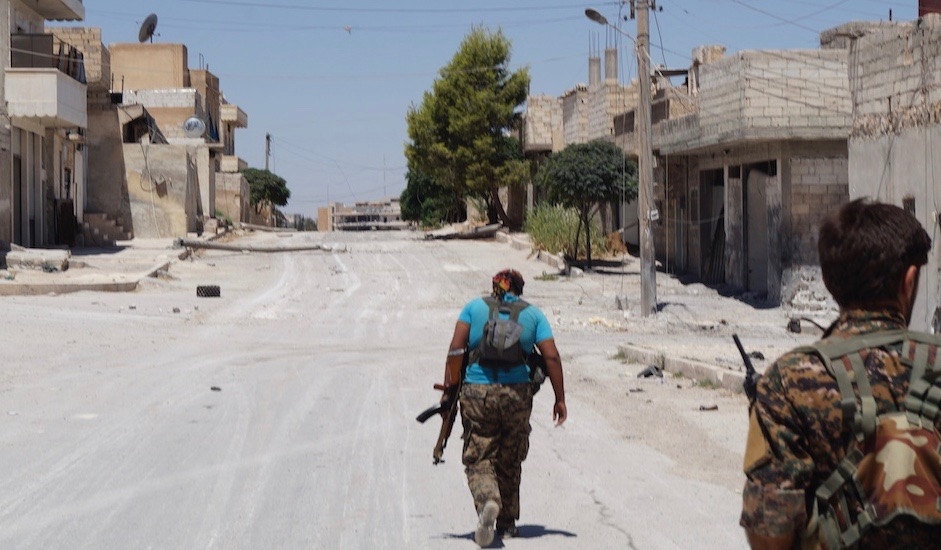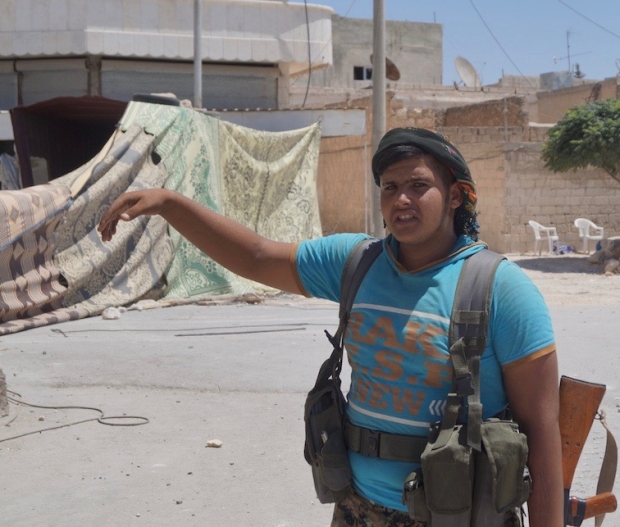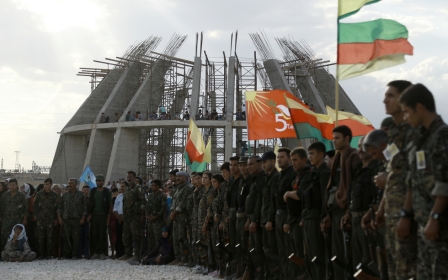US-backed SDF battles Islamic State over mean streets of Manbij

MANBIJ, Syria - US-backed Syrian Democratic Forces (SDF) have been fighting for more than two months against Islamic State (IS) group militants in Manbij, a city abounding with IS foreign fighters.
An air strike hits an IS position a few hundred metres from us, shaking the building. Local fighters continue drinking their tea. “It was probably a French air strike,” a local fighter says.
There is little media coverage of this operation because so few foreign journalists have been able to gain entry to northern Syria.
A French foreign volunteer with the codename Heval Gulhat also remains calm as the coalition air strike hits the IS position.
“First, I came here to fight, and secondly I came here to fight IS,” he tells me. “Here Daesh (an Arabic term for IS) attacks us just like in France; they're a common enemy,” he says.
The frontlines can be dangerous. A local TV journalist recently died from wounds suffered while covering the operation.
Roadside bombs have hurt civilians who were trying to flee.
On Friday, the SDF decided to temporarily restrict access for journalists after IS breached the frontlines and massacred dozens of civilians in the Arab village of Buyir.
Perhaps even more dangerous is the constant threat of IS snipers holed up in buildings.
“You can't leave your home because Daesh puts snipers on the rooftops,” says Abd Nasr Ali, a displaced civilian.
As a result, the streets are curtained off in many places for cover, but some streets are bare and you have to run. “Fast, fast,” a local SDF fighter urges as I cross the street.
An SDF fighter is brought in bleeding after being hit by an IS sniper's bullet.
“This is a battle from street to street and a battle for snipers. Heavy weapons and tanks can't be used anymore,” says Ahmed Mohammed, a member of the SDF-media centre who guides us and tells us we have to leave now after the fighter is wounded.
“We have to protect you and ensure your safety,” he says.
One fighter warns against venturing any further into Manbij because the frontlines are not fixed and houses and buildings easily change hands.
SDF fighters guide us through streets still sown with mines and IEDs. Ahmed points at a lumpen, soiled blanket. “That is an ISIS body,” he says. “We haven't had time to bury it yet, so we covered it.”
A local primary school inside Manbij city centre is still decorated with IS flags, but it's not possible to go inside. “Don't enter this building, we haven't cleared it yet and its most likely still mined,” Mohammed says.
There are no IS documents strewn around, as they have been collected for intelligence purposes. “You can't find any documents, everything has been taken by intelligence,” a local fighter says.
SDF intelligence has seized more than 10,000 documents from IS, including posters, cell phones, laptops, maps and other devices, Colonel Christopher Garver, the US-led coalition spokesperson said earlier.
“Exploitation of this information is ongoing to better understand Daesh networks and techniques, including the systems to manage the flow of foreign fighters into Syria and Iraq,” he added.
Meanwhile, every day civilians flee Manbij as SDF forces edge closer and closer towards the centre. Local kids flash victory signs in support of SDF forces or ask for bread.
In the emergency hospital in the town of Abu Kalkal, civilians are being treated for their injuries before transporting them to the larger town of Kobani. But the hospital lacks medicine and supplies.
Cries and shouts of women are heard as a boy is treated after stepping on a mine.
Isra Muslim, 12, a girl with innocent dark eyes, was badly wounded when she walked on an IS explosive. “My father came, and took me by my hands, since I couldn’t feel my legs,” she says.
On 19 July, the Syrian opposition, the Syrian government and human rights groups accused coalition jets of carrying out a massacre in the village of al-Tokhar, while ignoring the deaths of hundreds of Arab civilians at the hands of IS snipers and explosives.
Both the opposition and the Syrian government demanded a halt in the air strikes, but local civilians say the main problems are IS mines and snipers.
So far, the SDF have proposed two initiatives to evacuate civilians from the city, but IS has not responded. The militants know the battle would soon be over if there were no civilians to hamper air strikes.
Abu Noor, 41, a Turkmen from Manbij, said IS snipers killed his brother-in-law and wounded his sister and two-year-old child when they tried to flee the city. “I am not sure if the child is still alive; we will visit the hospital later," he says.
“Daesh just kill our people,” he adds. “The airplanes, they hunt IS, they don’t kill civilians. IS is taking civilians as human shields. We hope IS will be finished,” he says. “Abu Bakr al-Bagdadi is a dog, and a son of a dog,” he adds.
“IS is heartless and does not represent Islam."
Shamsa Mohammed, 50, who escaped the day before, tells MEE that IS kills civilians who try to flee. “We are happy to be here, we are celebrating. During Ramadan we had nothing to eat,” she says. “They don’t allow anyone out, if they had captured us, they would have destroyed us,” she says.
Abu Ahmed, 70, the pseudonym of a displaced civilian, has a similar story. “When we tried to escape, Daesh shot at us and my son was hit,” he says. “The Kurds took care of my son, and said they would bring food for me and my family,” he adds.
Nevertheless, he says, in some cases civilians do get killed by coalition air strikes.
“The Americans don't plan to attack civilians, but sometimes civilians get killed. When you throw a stone with your eyes closed and there are 10 children, for sure you will hit one of them, and this is a plane,” he says.
Civilians rejected a BBC report that life is better under IS. “I have my family still inside Manbij, and I cannot call them nor enter Manbij,” Abd Nasr Ali says. “How is there a better life under Daesh? They wear women's dresses, enter houses and kill people.
“Soon, civilians may attack Daesh. They have civilians by the throat,” he tells MEE. “There is no bread, no food, no water, and there are sick people,” he adds.
Female civilians particularly seem relieved to be liberated from IS, often removing the black niqabs they were forced to wear. While I am interviewing a displaced civilian from Manbij, a mother tells her son to burn the niqab before our eyes.
Mustafa Manbij, a stern-faced commander from the Manbij Military Council, arrives as we are leaving a grain silo from which SDF snipers target IS positions. Behind him, smoke rises from an exploded vehicle or air strike, as he dismounts from a locally made armoured vehicle that looks like it came from from a Mad Max movie.
“Are you working for [pro-opposition] Orient TV?” he says in a suspicious tone before finally agreeing to speak with me. “About 50 to 55 percent is under control, but the operation is going too slow because we have to first liberate civilians. IS is using civilians as human shields, so our special units are trying to liberate them. We are ready to pay the price to liberate them,” he says.
He rejects news reports that suggest SDF fighters or US-led coalition air strikes target civilians. “IS is using them as human shields and pushing them to the frontlines. Whoever says otherwise is lying, and helping IS, supporting IS,” he says.
Kurdish officials suggest that calls to halt US coalition air strikes in support of the SDF have the aim of preventing Kurds from creating a federal region of continuous territory by linking up the cantons of Kobani and Efrin.
“IS is like a pen with which we are drawing the border to Efrin,” Riaad Temmo, a Kurdish politician from the Left party, tells MEE in Kobane. “This is the same in Iraqi Kurdistan where the Peshmerga now control Shingal to Kirkuk. Kurdish blood is the ink of this pen that is drawing our new borders,” he says.
“The Syrian opposition says Syria should not be divided and controlled by one power,” Idris Nassan, a former Kurdish official, says in his house in Kobane.
“They don’t want this campaign to continue and reach Efrin,” he adds. “Even the government doesn’t like the advances of the SDF, but they can’t do much because the SDF is backed by the Americans,” he says.
Last Saturday, Pentagon spokesman Peter Cook assured the SDF forces of continued US support. “It is a place [Manbij] where we feel strongly that ISIL (IS) has planned external attacks outside of Syria,” he said.
“And that makes it all the more important that these local forces we’re supporting can capture this territory and remove ISIL from this area, and that requires air support by the coalition that we’ll continue to provide.”
New MEE newsletter: Jerusalem Dispatch
Sign up to get the latest insights and analysis on Israel-Palestine, alongside Turkey Unpacked and other MEE newsletters
Middle East Eye delivers independent and unrivalled coverage and analysis of the Middle East, North Africa and beyond. To learn more about republishing this content and the associated fees, please fill out this form. More about MEE can be found here.







